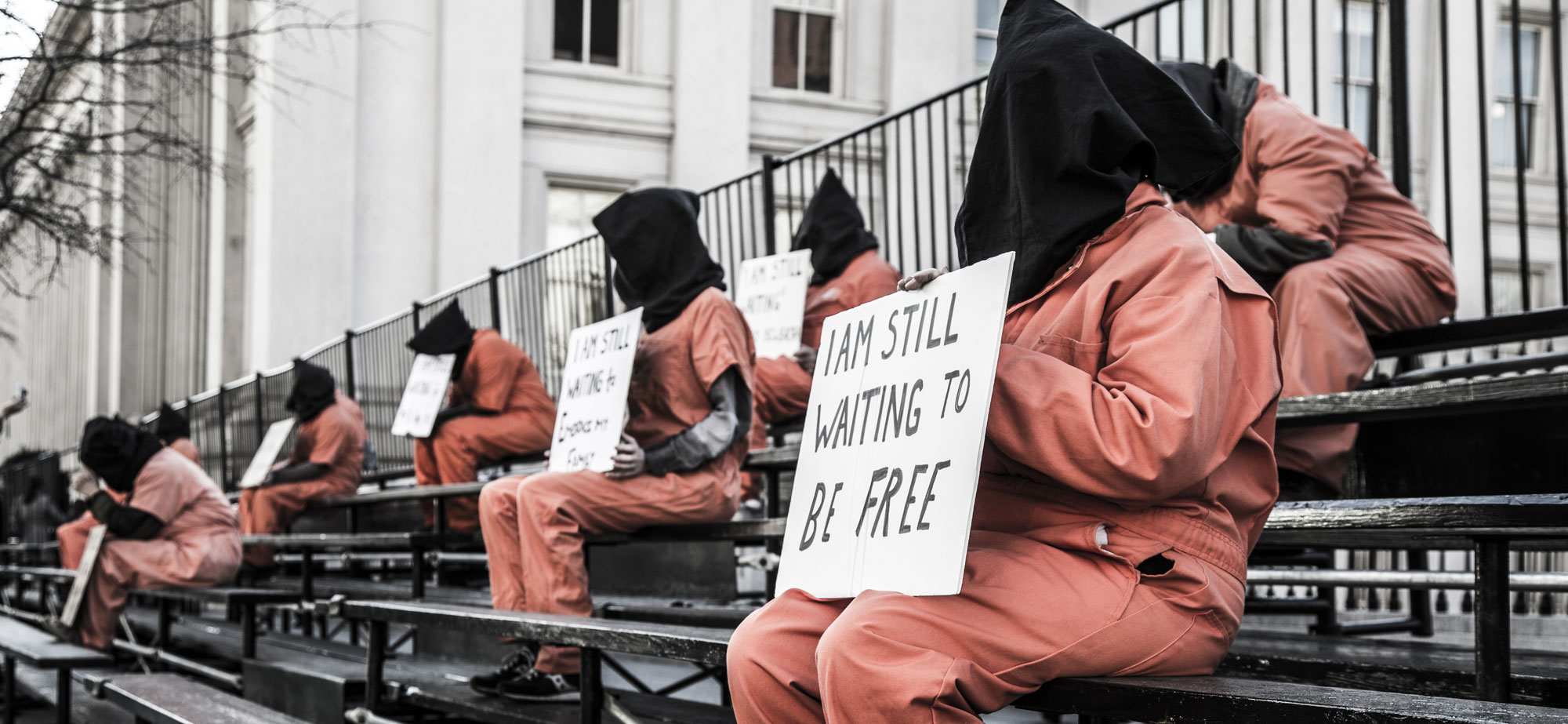From the Archive
Fast for Justice 2012: Day 1

Dear Friends,
In its opening statement of our court trial, the government repeatedly insisted that “this was not the time and place” – not the time to present our grievances against the continuation (or, as is recently evident, perpetuation) of Guantánamo, not the forum for debating these issues. And yet we maintain that now is always the time and place to speak out against Guantánamo.
This January 11th will be the tenth anniversary of the Guantánamo Bay detention center as the site of the torture and indefinite detention of men caught up in the United States “War on Terror.” Of the 171 men remaining there at this moment, eighty-nine are cleared for release but without any host country, most of the rest held without due process.
None of these facts, however clear and basic, are permissible in the courtroom. The prosecutors fear that it runs the “risk of enflaming the passions of the jury.” Justly so! But why this fear? There are many groups of people working to counter that fear and the bureaucracy that upholds it, many people working to create viable means of closing such detention centers as Guantánamo and Bagram. And so both within and beyond those restrictive courtroom walls, it is our hope that over the next ten days our fast and vigils, our presence and witness, all of this community building that connects each of us across this country and world… it is our hope to enflame to passions of humanity to trust in itself again.
In Peace,
Witness Against Torture
Contents
- DAY 1 – Update and Reflections (Compiled by Amy Nee)
- DAY 1 – Courtroom Analysis (By Molly Kafka)
- A link to the Blog of the Legal Times – http://tinyurl.com/7ove9ob
- A link to “Final Curtain: Obama Signs Indefinite Detention of Citizens Into Law As Final Act of 2011, by Jonathan Turley” – http://tinyurl.com/7uzqttd
- A link to Jan. 11, 2012 Press Advisory – http://2012.witnesstorture.org/pr-12-5-11
Video: Defendant Carmen Trotta
Update and Reflections
compiled by Amy Nee
Fasters from around the country began trickling into the hostel of First Trinity Church in D.C. yesterday for the start of our ten-day fast. After a final meal of pizza and salad those present gathered in a circle for the first of many “go arounds.” It was a time for introductions, orientation and logistics. Those gathered shared briefly their motivations for choosing to participate in the fast: We come to remember the prisoner, the murdered, to acknowledge and honor humanity, to practice spiritual discipline, to aim toward integrity, to create a space for introspection, for confronting torture, for visioning and experiencing a community of compassion and connectedness. Solidarity was mentioned time and again – with the men in Guantánamo, with prisoners, with community. The significance of community, too, continually rose to the surface – a source of focus, strength, hope and paradoxical joy as we come together to confront the devastating reality of sanctioned torture.
As a community began this day, with our first fasters check-in addressing the question, “how are you feeling?” The day promised an absence of food, and an abundance of shifting between vigiling in jumpsuits and sitting for hours on end in court. Amazingly, many of the responses to this question could be summed up with the word (a little dread and anxiety notwithstanding), “excited.” Jake led the morning reflection, sharing a poem by Shaikh Abdurraheem Muslim Dost,
“They Cannot Help.” Those who are charitable Cannot help but sacrifice for others.
They cannot help but face danger if they wish to remain true.
When they face injustice, dishonesty, and iniquity, They cannot help but be under the power of traitors and the notorious.
Consider what might compel a man To kill himself or another.
Does oppression not demand Some reaction against the oppressor?
It is natural that a man is driven to invention And to creation in times of duress.
The evildoer will be punished, He cannot avoid making amends, and must apologize eventually.
Those who foolishly dispute with Dost the Poet Cannot help but surrender, or else run away.
There is a temptation, Jake noted, toward violence as an outlet to this pent up frustration, humiliation, and devastation experienced by those in perpetual duress. And yet, we desire instead to embrace this energy and channel it toward hope. Oppression does indeed demand a response and so often we consider the option to be violence or passivity. Paki articulated an alternative, bringing to the circle a word from the philosopher Camus, that we ought be “neither victims nor executioners,” that there is a third way and we gather to create a space for an practice that way. It does not always feel like such a reasonable ambition, this passionate compassion that hopes to accomplish what evidence indicates is not likely. And yet, as Chrissy pointed out, hope is something unlike optimism, which tends to shift in accordance with circumstance and be influenced by logic; hope is a gift. We offer it to one another and try to share what we receive.
And so, emboldened by this hope we prepared to leave our current camp at the church and brave the cold of the outdoors and of the courtroom. While the defendants immediately entered the courtroom for a time of preparation, about twenty folks donned jumpsuits and hoods and preceded the trial with a vigil outside the courtroom before entering as an audience. There, what could have become an instance of hope deferred making the heart sick, was transformed. Carmen’s initial opening statement was barred, as was any mention of Guantánamo Bay and really any information having to do with why the defendants were present at the House. This was simply a case about their specific behavior at a specific time and whether or not it was disruptive. The tactics of the court were reminiscent of Brian Terrell’s reflection on Dost’s poem. It seems absurd, he commented, that this prisoner would write of himself, “Those who foolishly dispute with Dost the Poet/Cannot help but surrender, or else run away.” To all appearances those who contended with him won, but truly, Brian clarified, they did not contend openly, not justly, not boldly. The nature of violence, he said, is a way of shutting up. However, though the prosecution, with the consent of the judge, attempted to shut-up Carmen’s witness, he was able to quickly and eloquently revise it, presenting it with more clarity even than what had been previously prepared. (For a thorough account of the trial please see Molly Kafka’s trial write-up below). During a group evaluation following this first day of the trial, Brian Hines pointed out that the obstructions put before the defendants will not succeed in shutting them but rather, helps them along, “The way the opening worked out makes our lives easier, cleaner, clearer. Our case hangs on the fact that for years we were petitioning…driven on by an absence of response. In suppressing the global analysis of Guantánamo, the prosecutors and court allowed for the tenacity of our group…They’re sunk!”
Courtroom Analysis
by Molly Kafka
At the beginning of the trial, all of the original fourteen defendants were called to the defense table where nine of them were formally dismissed by the judge. The defendants representing themselves pro se are Brian Hynes, Judith Kelly, Mike Levinson, Josie Setzler, and Carmen Trotta. Two advising attorneys are assisting the five WAT activists all throughout the court proceedings. However, the individual defendants are taking on the various important roles of opening statement, direct and cross-examining witnesses, and closing statement.
The first major order of business was the jury selection. The judge presented a set list of questions, but both the defense and government possess the opportunity to suggest additional questions and the government did just that. Delightful to the defense, the government’s questions admitted to the jurors that the case is about political protest and the detention of men at Guantánamo Bay, and proceeded to ask whether any jurors felt strongly about either. This admission by the government set the tone for the trial; the defendants’ acts were absolutely about their First Amendment right to petition the House representatives concerning the closure of Guantánamo Bay.
Once the jury was selected they left the courtroom to allow the court to handle some preliminary matters. At this moment, the government expressed its intent to object to any aspect of the defense’s opening statement mentioning the name Guantánamo Bay, legislation and policies linked to it, any reference to the lack of due process of Guantánamo Bay prisoners, and any reference to the Bush or Obama administrations. Unfortunately, Judge Fisher agreed with most of the prosecution’s objections. He went so far as to require Carmen Trotta to present his opening statement before the court, including the government, yet excluding the jury, in order to determine whether Carmen’s statement would be admissible. Once he heard Carmen’s summary of his opening statement, the judge informed Carmen that he could not inform the jurors of why he and the other defendants read from a prepared statement calling on the House of Representatives to reject a congressional bill that would give continued financial support to Guantánamo Bay. Carmen responded that it was vital for him to mention Guantánamo Bay because “due process everywhere is being threatened and we have the privilege of due process here, right now.” The judge rejected Carmen’s pleas because he “does not want an improper politicization of the defendants’ charge.” Carmen was forced to scrap the majority of his carefully prepared opening statement in order to avoid being held in contempt for mentioning prohibited topics.
Once the preliminary business finished, the jurors returned to the courtroom and the government gave its opening statement. This statement claimed the House Gallery was not the time or place for the defendants to air their grievances. Even though the prosecution’s jury questions stated the case was about political protest and Guantánamo Bay, it changed its tune and said the exact opposite in its opening statement. The government claimed, “There is a time and place for everything, this was not it,” this case, the government contended, is not about Guantánamo Bay, protests, or even about the actual statement read by the defendants in the gallery. Instead, the government focused on the theory that Carmen stood up in the House Gallery at 4:35 p.m. on June 23rd, 2011 and unleashed “chaos” leading to distractions that caused “inefficiencies” in the House’s operations that afternoon.
Less than twenty minutes after the back-and-forth with Judge Fisher, Carmen Trotta rose to the occasion and presented the defense’s opening statement to the jury. Carmen began by first thanking the jury for participating in the due process of the defendants so they could be judged by a group of their peers. Carmen proceeded with grace and was able to convey to the jury the context of the defendants’ action without actually uttering the words Guantánamo Bay, saying, “You know why we’re here. I don’t need to tell you.” Carmen went on to clarify that the defendants did not yell, but “communicated volubly” in order for Congress to hear the defendants from the galleries. Carmen explained the defendants were simply exercising their First Amendment right of free speech and exercising their right to petition Congress for grievances conducted by Congress. The defendants did not disrupt Congress because the representatives continued to socialize on the House floor and cast their votes. Finally, Carmen eloquently appealed to the jury to take the evidence presented to them as they would a child, and nurture it. Carmen closed by stating, “What we did was simply an attempt of American citizens to express their grievances.”
The first day of court ended with the prosecution’s first witness, an officer for the Capitol Police. The police officer explained the general lay-out of the House Chambers and Gallery, the procedure in gaining admittance into the Gallery, and what he remembers occurring on June 23, 2011. He remembers the House was voting for a bill at approximately 4:35 p.m. when Carmen Trotta stood up in the Gallery and started speaking loudly. After about 15 seconds, the Speaker Pro Temporare hit the gavel and ordered the Sergeant at Arms to restore order in the gallery. Soon there after, the witness claims four to five more people stood up and also began speaking in the gallery. All of the defendants complied with the Capitol Police and did not resist arrest. While identifying the defendants the witness spotted Judith Kelly and with a bright smile said, “Oh yes, I remember her. She was very very nice.”



Join us on social media